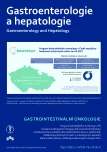Stent as a solution for perforation of the “black esophagus”
Authors:
Rys M. 1; Tomáš Fejfar 2; Rudolf Repák 2; Štěpán Šembera 2; M. Kopáčová 2; Ilja Tachecí 2
Authors‘ workplace:
Interní oddělení, Chrudimská nemocnice – Nemocnice Pardubického kraje, a. s.
1; II. interní gastroenterologická klinika LF UK a FN Hradec Králové
2
Published in:
Gastroent Hepatol 2022; 76(5): 442-446
Category:
doi:
https://doi.org/10.48095/ccgh2022442
Overview
“Black esophagus”, also known as acute esophageal necrosis (AEN), is a relatively rare disease characterized by black discoloration of the esophageal mucosa. The condition can be located only distally, but it can also affect the entire esophagus. Hematemesis is the most common clinical manifestation is; the condition is associated with increased lethality in high-risk groups of patients. Early diagnosis of AEN can be made by gastroscopy, the initiation of adequate treatment is crucial for a favorable patient prognosis. The most serious complications of AEN include esophageal perforation with the risk of other complications such as mediastinitis and sepsis. The nature of the disease and the affection of the esophagus and potentially the mediastinum require a multidisciplinary approach. Below we present a case report of a 68-year-old patient with a diagnosis of AEN complicated by perforation confirmed by CT and early endoscopy. An endoscopic approach with the introduction of a fully coated metal stent was chosen as the primary solution for the esophageal perforation. Nevertheless, the patient developed other complications of perforation: mediastinitis and empyema requiring chest drainage. In addition to interventional methods, the patient was treated with broad-spectrum antibiotics and a combination of parenteral and enteral nutrition. After 3 months of treatment and resolving the complications, the patient was released to outpatient care in a good clinical condition.
Keywords:
oesophageal perforation – acute esophageal necrosis – mediastinitis – Danis stent – metallic stent
Sources
1. Goldenberg SP, Wain SL, Marignani P. Acute necrotizing esophagitis. Gastroenterology 1990; 98 (2): 493–496. doi: 10.1016/0016-5085 (90) 90844-q.
2. Lamers CR, Mares WGN, Bac DJ. Black esophagus: a case series and literature review of acute esophageal necrosis. Scand J Gastroenterol 2018; 53 (10–11): 1421–1424. doi: 10.1080/00365521.2018.1513064.
3. Gurvits GE, Shapsis A, Lau N et al. Acute esophageal necrosis: a rare syndrome. J Gastroenterol 2007; 42 (1): 29–38. doi: 10.1007/s00535 - 006-1974-z.
4. Gurvits GE, Cherian K, Shami MN et al. Black esophagus: new insights and multicenter international experience in 2014. Dig Dis Sci 2015; 60 (2): 444–453. doi: 10.1007/s10620-014-33 82-1.
5. Ben Soussan E, Savoye G, Hochain P et al. Acute necrotizing esophagitis: a large retrospective case series. Endoscopy 2004; 56 (2): 213–217. doi: 10.1016/s0016-5107 (02) 70180-6.
6. Rejchrt S, Douda T, Kopácová M et al. Acute esophageal necrosis (black esophagus): endoscopic and histopathologic appearance. Endoscopy 2004; 36 (12): 1133. doi: 10.1055/s-2004-825971.
7. Siddiqi A, Chaudhary FS, Naqvi HA et al. Black esophagus: a syndrome of acute esophageal necrosis associated with active alcohol drinking. BMJ Open Gastroenterol 2020; 7 (1): e000466. doi: 10.1136/bmjgast-2020-000466.
8. Schizas D, Theochari NA, Mylonas KS et al. Acute esophageal necrosis: a systematic review and pooled analysis. World J Gastrointest Surg 2020; 12 (3): 104–115. doi: 10.4240/wjgs.v12.i3.104.
9. Day A, Sayegh M. Acute oesophageal necrosis: a case report and review of the literature. Int J Surg 2010; 8 (1): 6–14. doi: 10.1016/ j.ijsu.2009.09.014.
10. Kim SM, Song KH, Kang SH et al. Evaluation of prognostic factor and nature of acute esophageal necrosis: restropective multicenter study. Medicine (Baltimore) 2019; 98 (41): e17511. doi: 10.1097/MD.0000000000017511.
11. Abdullah HM, Ullah W, Abdallah M et al. Clinical presentations, management, and outcomes of acute esophageal necrosis: a systemic review. Expert Rev Gastroenterol Hepatol 2019; 13 (5): 507–514. doi: 10.1080/17474124.2019.1601555.
12. Maher MM, Nassar MI. Black esophagus: a case report. Cases J 2008; 1 (1): 367. doi: 10.1186/1757-1626-1-367.
13. Martins D, Marques R, Costa P et al. The dark side of the esophagus. Autops Case Rep 2021; 11: e2021284. doi: 10.4322/acr.2021.284.
14. Dias E, Santos-Antunes J, Macedo G. Diagnosis and management of acute esophageal necrosis. Ann Gastroenterol 2019; 32 (6): 529–540. doi: 10.20524/aog.2019.0418.
15. Akaishi R, Taniyama Y, Sakurai T et al. Acute esophageal necrosis with esophagus perforation treated by thoracoscopic subtotal esophagectomy and reconstructive surgery on a secondary esophageal stricture: a case report. Surg Case Rep 2019; 5 (1): 73. doi: 10.1186/s40792-019-0636-3.
16. Ali D, Detroz A, Gorur Y et al. Abrupt severe chest pain and vomiting: remember to think of a ruptured oesophagus (Boerhaave syndrome). Eur J Case Rep Intern Med 2019; 6 (10): 001265. doi: 10.12890/2019_001265.
17. Mishkin DS, Geruld D. Acute esophageal necrosis (black esophageus). In: Rose BD (ed). UpToDate. Watham MA 2020.
18. Messner Z, Gschwantler M, Resch H et al. Use of the Ella Danis stent in severe esophageal bleeding caused by acute necrotizing esophagitis. Endoscopy 2014; 46 (Suppl 1): E225–E226. doi: 10.1055/s-0034-1365384.
Labels
Paediatric gastroenterology Gastroenterology and hepatology SurgeryArticle was published in
Gastroenterology and Hepatology

2022 Issue 5
Most read in this issue
- Bile acid malabsorption in oncology patients
- Colorectal cancer screening program in the Czech Republic – 2021 quality indicators evaluation
- Správná odpověď na kvíz Syndrom arteria mesenterica superior, syndrom Wilkie
- Stent as a solution for perforation of the “black esophagus”
